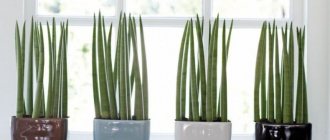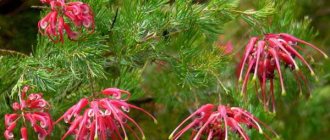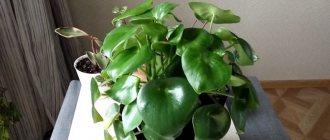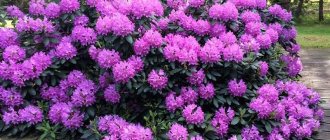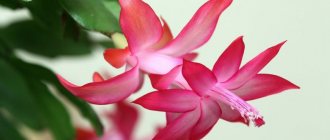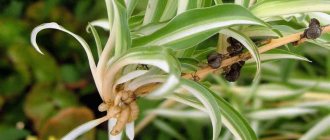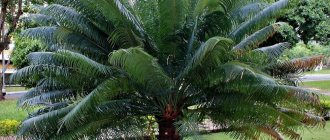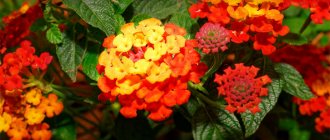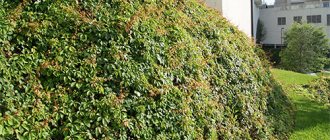In appearance, this indoor flower resembles a large, intensely green tuft of grass and, indeed, in its country of origin it is planted under trees as a ground cover plant. In our country, chlorophytum is grown as a home ornamental plant. It is undemanding, adapts well to environmental conditions, and rarely becomes a victim of pests - this is a good choice for beginning gardeners! In addition, it purifies the air and reproduces easily. From this article you will learn how to grow chlorophytum - care at home, how to propagate it.
Short review
- Plant family: Asparagus (lat. Anthericaceae)
- Genus: Chlorophytum
- Order: Asparagus (lat. Asparagales)
- Species: Chlorophytum crested (lat. Chlorophytum comosum)
- Trivial names: green lily, family happiness
- Origin: South Africa
- perennial herbaceous plant
- Growth height: up to 60 cm
- Flowering: Possible all year round, small white flowers on long flower stems (tendrils)
- Leaves are from 20 to 45 cm long, 6 to 25 mm wide - in rosettes
Thanks to its fast and bushy growth, Chlorophytum crested has become one of the most popular indoor and office plants in the world. Its original homeland is South Africa. Chlorophytum entered European living rooms in the mid-19th century. Wild specimens with pure green leaves also grow today in various subtropical and tropical areas.
Cultivated forms of Chlorophytum crested have green leaves with a white or yellow stripe in the middle.
Description of the plant
The herbaceous perennial produces thick tuberous root shoots of yellow or brown color. The powerful root system accumulates a large amount of moisture from the soil and is able to nourish the crop without watering for a long time. A short stem grows from the root rosette, on which a large number of narrow, pointed leaves 1.5-2 cm wide are formed. The full life cycle of chlorophytum is 10 years. Periodically, dense flexible tendrils grow from the stem, on which miniature bushes with leaves and aerial roots appear. The representative of the flora blooms in spring and autumn with small white or light green flowers on long shoots. In place of faded elements, seed pods are formed.
Chlorophytum - benefits for the home
Due to its ease of care, Chlorophytum crested is often used as an ornamental plant in offices and residential areas.
The distinctive feature of Chlorophytum crested was discovered by American scientists in 1984. The study found that the plant can improve polluted air by filtering substances such as formaldehyde. This works especially well in enclosed spaces.
Chlorophytum crested: varieties
There are about 190 wild and cultivated varieties of Chlorophytum crested in the world. The most common varieties are:
Chlorophytum variegatum (lat. Chlorophytum comosum Variegatum)
- has at least one white stripe in the middle of each leaf and is the most common type of houseplant.
Chlorophytum Vittatum (lat. Chlorophytum comosum Vittatum)
- also has green-white leaves that are shorter and narrower than those of Chorophytum variegatum.
Chlorophytum Ocean (lat. Chlorophytum comosum Ocean)
- is the youngest variety and is characterized by light green leaves with a white edge.
Chlorophytum Picturatum (lat. Chlorophytum comosum Picturatum)
- produces green leaves with a yellow stripe in the middle.
Chlorophytum Bonnie (lat. Chlorophytum comosum Bonnie)
- has green-white twisted (curly) leaves.
Chlorophytum Mandainum (lat. Chlorophytum comosum Mandainum)
- has particularly short, dark green leaves with a yellow central stripe.
Chlorophytum crested (lat. Chlorophytum comosum)
- The wild form of Chlorophytum crested is characterized by purely green leaves without any patterns or stripes.
Chlorophytum crested: cultivation and care
Chlorophytum crested is a very low-maintenance houseplant that survives in many situations. However, there are a few things to consider to create a healthy environment for your plants. Species-appropriate care will ensure that Chlorophytum crested will thrive and reproduce for decades.
Chlorophytum crested (lat. Chlorophytum comosum)
Location
An unpretentious plant feels comfortable in a bright place. Ideal places are where chlorophytum comes into direct contact with the sun in the morning or evening. Sunlight helps the plant develop better. However, chlorophytum should not be exposed to hot midday sun in summer.
A partially shaded location is also a good option. However, the plant grows slower in dark places and shade. Low temperatures also slow growth. Chlorophytum thrives best when the room temperature is as constant as possible, between 14°C and 18°C. It typically withstands temperatures between 10°C and 30°C.
Chlorophytum crested should be placed indoors rather than outdoors, especially during cooler months. In summer it also thrives on the balcony or garden, as long as it is not constantly exposed to direct sunlight.
Warning: Chlorophytum is a popular target for cats. They love to chew on its long leaves.
Substrate
The following is suitable as a substrate for chlorophytum:
- regular soil for flowers;
- compost-based soil mixture;
- homogeneous peat-clay soil.
The substrate should have a pH of 6 to 7, that is, it should be slightly acidic or neutral.
Transfer
Chlorophytum's dense and fast-growing root ball requires a lot of space, so the plant should be placed in a pot or hanging vase with sufficient space. Between the roots and the edge of the pot there should be an area 2 to 3 cm thick filled with soil.
As soon as roots become visible, which displace the substrate to the surface or even damage the pot, chlorophytum should be transplanted into a large container as soon as possible, regardless of the time of year.
Watering
Chlorophytum crested needs to be watered regularly with plenty of water. The soil may be constantly slightly damp, especially from spring to autumn. However, waterlogging should be avoided. Therefore, it is better to plant the plant in a pot with a drain hole. In this case, the water is removed a few minutes after watering.
The green plant can store water in its thick roots, so it can withstand short dry periods. However, such periods should not take too long and should not be repeated too often. You can quickly see from dry leaf tips, pest infestations and light, wilted leaves that Chlorophytum is not getting enough water.
Brown leaf tips may also indicate that indoor humidity is too low. It should be between 50% and 70%. If the air humidity is too low, it is necessary to regularly spray the plant with water.
Fertilizer
Caring for chlorophytum also includes supplying the plant with nutrients. Targeted fertilizer stimulates overall plant growth, resulting in the formation of new leaves and numerous shoots. However, the overall nutrient requirement of chlorophytum is quite low.
During the main growing season, which runs from March to September, it is recommended to add a little liquid fertilizer to the soil every two to four weeks. Basic soil fertilization should be from 1 to 1.5 kg per cubic meter. A balanced complex fertilizer is used.
The exact amount of fertilizer depends on the nutrient content of the substrate. For example, if chlorophytum is replanted every year, then no fertilizer is required.
Wintering
At room temperature, Chlorophytum crested thrives year-round. In winter, however, it is necessary to give the plant a rest and not fertilize it. If chlorophytum is located in a cool place, you should make sure that the air temperature is at least 10 °C. At these low temperatures, it needs less water than during the main growing season. In this case, the plant should be watered when the surface of the earth dries out a little.
Watering
Abundant, but in moderation. Do not overdry or over-moisten the soil.
In summer, the flower is watered often - every 2-3 days, on hot days - more often. In winter, once a week is enough, when the soil is partially dry, but make sure that the soil does not dry out completely.
It tolerates infrequent watering due to the peculiarities of the root system, but with constant overdrying it loses its decorative qualities.
In summer it is useful to have a warm shower.
If water gets into the center of the socket, carefully remove the moisture.
It does not require high humidity, but if there is a lack of it, the tips of the leaves may dry out. In this case, additional air humidification is required.
Chlorophytum crested: reproduction
With proper care, Chlorophytum crested is very prolific and multiplies quickly. This is done using the following methods:
Children
Since chlorophytum produces many children, propagating it in this way is the fastest option. Small daughter plants emerge from the flowers after they wither. The flowers grow in small bunches on pendulous flower stems up to 75 cm long, so multiple shoots can develop from each stem.
Young children form roots in the air and pull the stems with their weight towards the ground.
The baby can be separated from the mother plant once it has at least five leaves about five centimeters long. If the baby already has roots at least three centimeters long, the young plant can be immediately planted in a separate pot. The baby grows quickly at room temperature around 20 °C.
If the roots are shorter, place the separated baby in water first. In addition, the stem of the mother plant on which the baby grows can be placed in a pot of soil without separation. Once the daughter plant has taken root after a few weeks, the stem is cut off. The more often the children are separated from the mother plant, the more the growth of new flower stems is stimulated.
Chlorophytum crested (lat. Chlorophytum comosum)
Seeds
The wild form and several cultivated varieties of Chlorophytum crested form small capsule fruits in which three seeds ripen. If the capsule bursts, black seeds fall to the ground. Such propagation occurs mainly during professional plant selection and less often in private farms.
Dividing the plant
Chlorophytum crested can be propagated by dividing the plant into two or more parts. This method is especially suitable if the mother plant has become too large.
Rules for planting seedlings
Caring for chlorophytum crested at home begins with planting it. Fortunately, this process does not cause difficulties, because this flower is one of the most unpretentious and resilient (Figure 4).
Figure 4. For proper planting, you need to prepare a soil mixture and a pot with drainage
Of course, in order to grow a truly lush and beautiful bush, it is still better to choose the right soil and a pot of the appropriate size, and when the plant takes root and acclimatizes in a new place, provide it with optimal care.
Chlorophytum crested: diseases and pests
Because Chlorophytum crested is hardy and easy to care for, diseases are rare. Dried leaves often indicate waterlogging, which should be corrected as soon as possible by draining excess water. If waterlogging continues, the plant can become infected with bacteria that can cause severe bacterial wet rot. These bacteria spread quickly and are difficult to control. Therefore, throw away affected plants and protect healthy specimens from contact with them.
Aphid
When infested by aphids, chlorophytum exhibits the following symptoms:
- there are a lot of small aphids on the underside of the leaves;
- leaves curl strongly;
- bubbles form on the surface of the leaf;
- the plant becomes sticky;
- the children are fading.
To remove aphids, chlorophytum is thoroughly sprayed on all sides with a mixture of water and detergent. Repeat the process every two to three days until the aphids are gone. You can also use insecticides.
Mealybugs
Mealybugs can also harm chlorophytum. Their white bodies are easy to see against the green leaves. Infection is also indicated by the fact that the leaves change color and shrink. The scale insects secrete honeydew, which collects on the plant.
To prevent chlorophytum from dying, the plant should be quickly treated with a pest control agent. After about two weeks, the appropriate insecticide must be used again as it does not work against insect eggs.
As soon as you discover an infestation, isolate the affected plant. This will prevent further spread of pests.
Whiteflies
Whiteflies can be controlled using insecticides or a yellow sticky sticker. Signs of chlorophytum infection by these pests:
- if you move a plant, insects fly up;
- the leaves first turn yellow, then become spotted;
- subsequently the leaves dry out and then fall off;
- Honeydew collects on the upper side of the leaf.
Spider mites
Small pests are found especially in winter. They can be seen due to small light dots on the leaves. If infested for a long time, the leaves slowly turn brown and dry out. Place the affected plant in the shower and rinse thoroughly. Then cover it completely with a plastic bag, close it tightly and place the plant in place.
The humidity inside the bag will increase. The package must be left on the plant for at least two weeks. This leads to the death of spider mites. If this method is not sufficient to completely control the mites, the plant can be sprayed carefully with insecticides.
Cats
Chlorophytum crested magically attracts cats. Pets are not pests in the classic sense, but they do enjoy chewing on the long leaves. Bite marks look very unsightly. Eating chlorophytum can also be harmful to cats because the plant absorbs pollutants from the air and fertilizers accumulate in the leaves.
